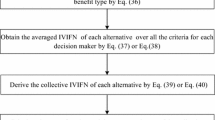Abstract
In this paper, group decision making methods based on intuitionistic fuzzy multiplicative preference relations has been developed. For it, firstly some new operational laws on intuitionistic multiplicative numbers have been defined and then by using these operations some new intuitionistic fuzzy multiplicative interactive weighted geometric, intuitionistic fuzzy multiplicative interactive ordered weighted geometric and intuitionistic fuzzy multiplicative interactive hybrid weighted geometric operators have been developed. Some desirable properties of these operators, such as idempotency, boundedness, monotonicity etc., are studied in the paper. The major advantage of the proposed operators as compared to existing ones are that it consider the proper interaction between the membership and non-membership functions and proposed operators are more pessimistic than existing ones. Furthermore, these operators are applied to decision making problems in which experts provide theory preference relation by intuitionistic fuzzy multiplicative intuitionistic fuzzy environment to show the validity, practicality and effectiveness of the new approach. Finally, a systematic comparison between the existing work and the proposed work has been given.
Similar content being viewed by others
References
Atanassov K, Gargov G (1989) Interval-valued intuitionistic fuzzy sets. Fuzzy Sets Syst 31:343–349
Attanassov KT (1986) Intuitionistic fuzzy sets. Fuzzy Sets Syst 20:87–96
Deshrijver G, Kerre E (2002) A generalizationof opertors on intuitionistic fuzzy sets using triangular fuzzy t-norms and t-conorms. IEEE Trans Fuzzy Syst 8(1):19–27
Garg H, Agarwal N, Tripathi A (2015) Entropy based multi-criteria decision making method under fuzzy environment and unknown attribute weights. Glob J Technol Optim 6:13–20
He Y, Chen H, Zhou L, Han B, Zhao Q, Liu J (2014) Generalized intuitionistic fuzzy geometric interaction operators and their application to decision making. Expert Syst Appl 41:2484–2495
Liao H, Xu Z (2014) Priorities of intuitionistic fuzzy preference relation based on multiplicative consistency. IEEE Trans Fuzzy Syst 22(6):1669–1681
Liu P (2014) Some hamacher aggregation operators based on the interval-valued intuitionistic fuzzy numbers and their application to group decision making. IEEE Trans Fuzzy Syst 22(1):83–97
Liu P, Liu Z, Zhang X (2014) Some intuitionistic uncertain linguistic heronian mean operators and their application to group decision making. Appl Math Comput 230:570–586
Liu P, Yanchang C, Yanwei L (2015) The multi-attribute group decision-making method based on the interval grey uncertain linguistic variable generalized hybrid averaging operator. Neural Comput Appl 26(6):1395–1405
Liu P, Yu X (2014) 2-dimension uncertain linguistic power generalized weighted aggregation operator and its application for multiple attribute group decision making. Knowl-Based Syst 57(1):69–80
Orlovsky SA (1978) Decision-making with a fuzzy preference relation. Fuzzy Sets Syst 1:155–167
Saaty TL (1986) Axiomatic foundation of the analytic hierarchy process. Manag Sci 32(7):841–845
Wang W, Liu X (2012) Intuitionistic fuzzy information aggregation using einstein operations. IEEE Trans Fuzzy Syst 20(5):923–938
Wang WZ, Liu XW (2011) Intuitionistic fuzzy geometric aggregation operators based on Einstein operations. Int J Intel Syst 26:1049–1075
Wang X, Dong C (2009) Improving generalization of fuzzy if-then rules by maximizing fuzzy entropy. IEEE Trans Fuzzy Syst 17(3):556–567
Wang X, Dong L, Yan J (2012) Maximum ambiguity based sample selection in fuzzy decision tree induction. IEEE Trans Knowl Data Eng 24(8):1491–1505
Wang X, Xing H, Li Y, Hua Q, Dong CR, Pedrycz W (2014) A study on relationship between generalization abilities and fuzziness of base classifiers in ensemble learning. IEEE Trans Fuzzy Syst. doi:10.1109/TFUZZ.2014.2371479
Wei G (2010) Some induced geometric aggregation operators with intuitionistic fuzzy information and their application to group decision making. Appl Soft Comput 10:423–431
Wei GW, Zhao XF (2012) Some induced correlated aggregating operators with intuitionistic fuzzy information and their application to multiple attribute group decision making. Expert Syst Appl 39(2):2026–2034
Xia M, Xu Z, Liao H (2013) Preference relations based on intuitionistic multiplicative information. IEEE Trans Fuzzy Syst 21(1):113–132
Xu ZA, Xia M (2003) Induced generalized intuitionistic fuzzy operators. Knowl Based Syst 24(2):197–209
Xu ZS (2007) Intuitionistic fuzzy aggregation operators. IEEE Trans Fuzzy Syst 15:1179–1187
Xu ZS (2007) Intuitionistic preference relations and their application in group decision making. Inf Sci 177:2363–2379
Xu ZS (2007) A survey of preference relations. Int J Gen Syst 36:179–203
Xu ZS, Yager RR (2006) Some geometric aggregation operators based on intuitionistic fuzzy sets. Int J Gen Syst 35:417–433
Yu D (2015) Intuitionistic fuzzy theory based typhoon disaster evaluation in Zhejiang province, China: a comparative perspective. Nat Hazards 75(3):2559–2576
Yu D, Merigo JM, Zhou L (2013) Interval-valued multiplicative intuitionistic fuzzy preference relations. Int J Fuzzy Syst 15(4):412–422
Zadeh LA (1965) Fuzzy sets. Inf Control 8:338–353
Zhao H, Xu Z, Ni M, Liu S (2010) Generalized aggregation operators for intuitionistic fuzzy sets. Int J Intel Syst 25(1):1–30
Acknowledgments
The authors are thankful to the Editor-in-Chief and anonymous referees for their valuable comments and suggestions.
Author information
Authors and Affiliations
Corresponding author
Rights and permissions
About this article
Cite this article
Garg, H. Generalized intuitionistic fuzzy multiplicative interactive geometric operators and their application to multiple criteria decision making. Int. J. Mach. Learn. & Cyber. 7, 1075–1092 (2016). https://doi.org/10.1007/s13042-015-0432-8
Received:
Accepted:
Published:
Issue Date:
DOI: https://doi.org/10.1007/s13042-015-0432-8



